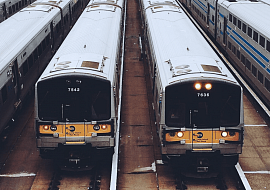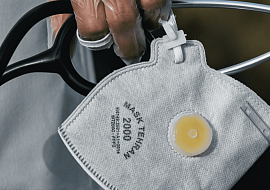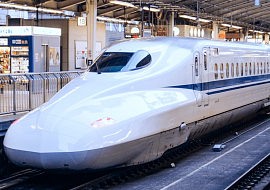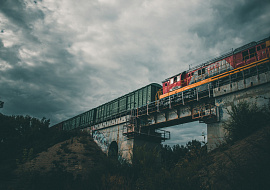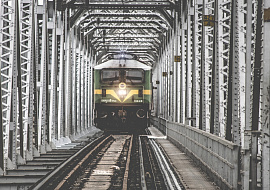Railway innovative solutions: Who benefits and who loses?
Today, safety remains a top priority in the railway industry. However, in some areas, such as passenger transportation and logistics, companies are considering innovating to stay competitive. Regardless, many railway companies are in no hurry to explore innovative solutions, considering all the benefits. So, a majority of news about innovative rail signaling solutions are becoming big ones not only in the railway environment but also around the world.
Let’s consider the following: what arguments can we make that are either for or against innovations within rail? Is sticking to the conservative path a wise choice in the modern world? To answer these questions, PSA has collectively compiled extensive data from our long experience of working in the rail industry. Let's consider which rail solutions are most relevant for certain companies and whether or not they should fast-track their North American implementation.
Arguments around implementing innovative railway signaling solutions
Some rail companies may be resistant to innovation for fear of destroying a functioning, revenue-generating system. The mindset of these innovation opponents and slow adopters is "Why should we change something that has worked for so long?" On the other hand, proponents of innovative railway signaling solutions are actively adopting these changes; some risking their reputations by entrusting inexperienced startups to modernize critical components like trains, controllers, and cabs. Both arguments often start with the same issues: security, structure, competition, and cost. Let's examine these next.
Innovations require major companies to restructure
Driven by the idea of becoming an innovative leader, the company is likely not to consider that any innovation will have to fit into the existing corporate structure or otherwise alter its business model. For large, highly structured companies, changing business methods is the biggest challenge, which can even crowd out the benefits of those innovations. Historically, the railway industry is one of the most tightly organized, making disruptive innovations difficult to succeed. While incremental innovations are more manageable, their implementation is still a complex, costly, and time-consuming process.
In contrast, every business model has its own life cycle. Keeping this in mind, a railway company may eventually fall into decline if it does not change its business strategy. Although railroads adopt improvements slowly, they eventually do. When a company ignores the benefits of innovation, however, it risks falling behind competitors and losing profits.
It is nevertheless crucial to assess whether a particular railway innovative solution can be embraced and scaled up. Considering the highly structured nature of railroad companies, they would be better off accepting innovations that conform to their existing structure and incorporating them gradually. If a disruptive innovation fits within the organization's structure, it is more likely to succeed than a generic incremental solution that forces the company to reshape its business processes.
No competition — no need for innovations?
Innovation is no longer needed if new players simply do not enter the market, right? The main idea behind the global introduction of any innovation in digital markets is companies’ intention to stay competitive, therefore, get more revenue. In the face of intense competition, businesses have to come up with more creative, eco-friendly, and cost-effective solutions. Since the US rail transportation market is densely populated, it is incredibly difficult for a startup to break into it. In the absence of competition, other factors guarantee the success of the solutions. In the case of the railway industry, safety is paramount. However, safety seldom votes for innovation.
When looking at the US rail transport industry as a whole, we see that competition is well developed here. Although rail companies do not compete with each other much, as Real Clear Markets proves in their article, they actually fight for a place in the market with other modes of transport. Unfortunately, rail transport is losing ground. For instance, the trucking industry used to transport over 15 percent more freight than rail before the pandemic. For logistics companies to shift their focus to rail, it is necessary to develop innovations. Railway transport already has many advantages over trucks: trains are faster, more reliable, and automated. Additionally, railway transport relieves traffic congestion, reduces greenhouse gas emissions, and reduces transportation costs, including government expenditures in this area.

As the railway industry continues to consolidate, it gains a competitive advantage over other alternatives. Many railroads are merging. Regional rail companies are working together along the supply chain to transport cargo on Class I railroads. This merging of railroads is facilitated by innovation since the rail companies will be more disposed to work with partners who have modernized their assets.
By some estimates, freight traffic volume in North America is predicted to increase by 40% by 2040 due to an increase in traffic congestion. Knowing this, the time will come to unleash the full potential of rail transport through innovative technologies, such as autonomous and smart trains. The use of new technologies can also improve the supply chain, making the railways more attractive for shippers. With the help of Enterprise IoT Solutions, you can accurately track where the cargo is, check its condition, predict the impact of weather, monitor energy consumption and driver habits, and perform predictive maintenance. It is more advantageous for customers to work with a company that has a lower risk of cargo damage.
Safety risks vs safety improvements: role of signaling innovations
The core principles of security are risk avoidance, caution, and strict regulation. By their very nature, these boundaries also inhibit innovation. Safety on railroads is primarily determined by the signaling system, which ensures that trains don't collide with one another. Setting up a system of this complexity is challenging enough. Many railroads in the US still work with controllers from the middle of the last century and use technologies from the century before last. It is a reliable system. This is why many companies are unwilling to change.
Thankfully, old primitive electrical enclosures are no longer the limit in ensuring security. Over time, the Automatic Train Protection (ATP) system has appeared, which is capable of making an automatic stop after checking signals and the speed of the train. Some train protection systems like ETCS (European Train Control System) and PTC (Positive Train Control) were first implemented on the Vienna-Budapest line and on the Metrolink in Southern California before becoming widespread at various locations around the world.
The real breakthrough came in 2019, when the FRA (Federal Railroad Administration) opened the way for driverless trains, after determining that having 2 pilots was not improving safety. Despite this, there are more examples of unsuccessful innovation implementations, when companies have decided to start a project in a rush. For instance, the decision to match one supplier’s interlocking with another supplier’s CBTC through two separate contracts. Keep in mind that interoperability between different vendors is not achieved by default just because they work on the same technology.
Searching for a railway signaling solutions for your station?
As one interesting example, we can take the ENYSE company, which at the beginning of 2022 announced that it is going to create an innovative railway signaling system on the AdaCore platform. A microprocessor-based system will be its cornerstone. Another good example is the new train control system that Siemens has implemented in the Copenhagen S-Tog network. It will allow the operator to reduce the interval of train traffic from 120 to 70 seconds within the city. Hence, examples of signaling systems modernization do exist and they have a chance to become successful. However, you should carefully analyze all your assets and estimate the real benefits of introducing innovations before implementing a similar project.
Investing in innovation: Will it pay off, or not?
When thinking about innovating a product, rail companies do not always see the monetary benefits of doing so. For example, they might feel that it doesn't matter how modern the signaling system is, as long as it provides a sufficient level of safety. By updating equipment using proven methods, companies can maintain its functionality, upholding the reputation of a reliable partner. Additionally, the railway market is especially closed off. Competitors will not share the secrets of their innovations, or disclose any best practices. This makes it harder to estimate how useful the innovation will be and how it will pay off. Only service innovations are clear enough and their benefits can be seen in a reasonable timeframe.
On the other hand, when it comes to innovation, so much depends on how far into the future you look. It is fairly difficult to predict whether a conditional innovative signaling system will become a trend around the world, or whether the existing one will remain the gold standard. Therefore, there is no special recipe for the railway industry: it is also necessary to evaluate the profitability of innovations and develop a unique strategy for their implementation.
What types of innovations are suitable for the railway industry?
The Intelligent Railway Transport System Market is expected to grow by 26.6% until December 2022. It means the usage of the latest technologies to manage the railway industry, and its services is getting more popular. Most rail innovations won’t induce companies to completely reformat their business approach, but only push them to improve some specific areas, and rightly so. As we noted above, highly structured companies will have a hard time adjusting to disruptive innovations.
First, we would like to point out that innovative railway signaling solutions can help companies solve critical issues. Rail companies have to follow the rules established by the FRA, including maintaining infrastructure objects, e.g. tunnels, and bridges, which can be much easier to do with innovations. For instance, using drones or smart sensors, operators can monitor the state of the equipment and perform predictive maintenance.
Regarding the railway industry, the respective innovations can enhance:
-
The safety level on the railway
-
Cargo transportation efficiency
-
Passenger traffic
-
Company’s profit
The implementation of smart technologies definitely reduces the risk of human error, which improves the level of safety. Smart sensors and drones, as mentioned above, can be used to measure different parameters of equipment in real-time. Sensors in railways proved to be excellent back in the late 1990s when they started to track wheel defects and the location of the train. This information can also be sent to the server and analyzed to identify patterns of breaking. This way, operators will be able to properly assess issues before they occur. Using AI solutions in the train control system, it is possible to help the driver to detect obstacles on the tracks and around them. Improving the security system on the railway is always an expensive task and does not pay off immediately.
Improved user experience can convince passengers to choose the train over the other modes of transport. It can be reached through innovations that help trains arrive on time; digital screens that help them navigate, apps or chatbots, helping to buy a ticket online, a climate control system in a train, speed improvements, and so on. In general, these innovations are the easiest to implement: they are incremental and do not require a major overhaul of the business model. By offering passengers an opportunity to install special applications, you can receive feedback from them about the trip and always be aware of how effectively the innovation takes root.
The IoT ecosystem is indispensable when it comes to logistics improvements. The same smart sensors will help to track the location and condition of the cargo, monitor energy consumption and driver habits, perform predictive maintenance, and give access to the data about cargo to clients. It will be also possible to predict the impact of weather or other conditions. In case of some issue, for instance, cargo delay or loss, it would be easy to determine its cause and solve it quickly.
One key question here is how does innovation affect costs and profits? First, predictive maintenance prevents downtime and technical breakdowns that reduce costs and provide you with a better return on your investment (ROI). IoT and AI technologies can replace people in some positions, which will also regularly save money. Additionally, customer satisfaction is likely to help increase revenue. This is true both for passenger transportation, where the level of customer comfort is critically important and for freight, where technology can provide faster and better delivery. Thoughtful, forward-thinking innovation can also attract partners. If a company sees the potential in the innovative railway signaling solutions, this can be a decisive factor that they will want to do business with you.
Conclusions
Is there a place for innovation and new technologies in the railway industry? Absolutely. However, proponents of innovations shouldn't be rushing to implement them, risking their business and reputation. The implementation of new technologies in any company requires a well-developed strategy and a detailed business plan. Regarding the railway industry, any risks should be eliminated.
We believe that innovations can be introduced when:
- They match the structure of the company and will not require a radical redesign of its business model
- The company is ready to invest significant resources into innovation, which will maintain and improve its position in the market
- The railway industry in particular lags behind its transport competitors and needs equipment modernization
- The proposed innovations are supposed to be incremental and are designed to improve customer satisfaction








